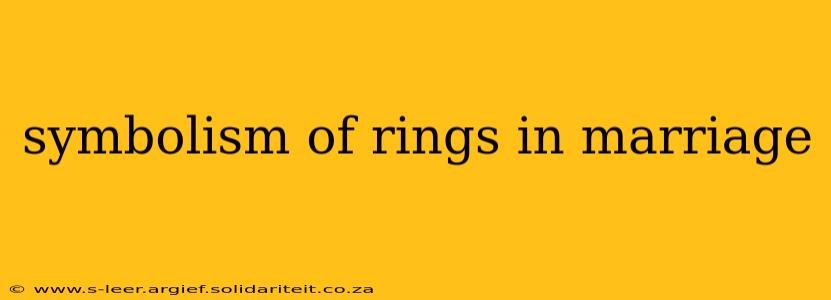Wedding rings. These simple bands of metal hold a weight of meaning far exceeding their physical presence. They represent a commitment, a promise, a lifelong journey shared between two individuals. But the symbolism goes far deeper than a simple vow. This exploration delves into the rich history and evolving interpretations of the wedding ring, uncovering the powerful message embedded within this enduring symbol.
What does a wedding ring symbolize?
At its core, the wedding ring symbolizes eternal love and commitment. The unbroken circle represents infinity, signifying a bond without end. The placement on the fourth finger of the left hand – the "ring finger" – further enhances this symbolism. Ancient cultures believed this finger contained the vena amoris, a vein that ran directly to the heart, connecting the couple's love physically and metaphorically. While this anatomical belief has since been debunked, the tradition persists, adding a layer of romantic mystique to the gesture. Beyond the romantic, the ring also serves as a public declaration of marriage, a visible sign of commitment to the world.
Why do we wear wedding rings on the fourth finger?
As mentioned above, the tradition of wearing a wedding ring on the fourth finger of the left hand stems from the ancient belief in the vena amoris. This belief, though unfounded in modern anatomy, beautifully encapsulates the enduring idea of a direct connection between the heart and the commitment represented by the ring. The continued practice, even after the myth's debunking, highlights the enduring power of tradition and the symbolic resonance of the ring's placement. It's a subtle yet powerful reminder of the wearer's marital status and devotion.
What is the history of wedding rings?
The history of wedding rings stretches back millennia. Early forms date back to ancient Egypt, where rings were made of braided reeds or hemp. These evolved into metal rings, often featuring precious stones or simple designs. The Romans adopted the practice, adding further significance with the use of iron rings, symbolizing strength and endurance. Over time, materials and designs varied across cultures and eras, yet the core symbolism of unending commitment remained constant. The modern-day simplicity of the wedding band reflects a shift towards understated elegance, yet the powerful meaning persists, connecting modern couples to a rich and ancient tradition.
What are different types of wedding rings?
The diverse landscape of wedding rings reflects evolving tastes and cultural influences. While simple bands remain popular, variations abound:
- Metal: From classic yellow gold and platinum to modern rose gold and palladium, the choice of metal adds a personal touch.
- Style: Plain bands maintain a timeless appeal, while intricate carvings, gemstones, and unique designs allow for personalization.
- Width: The width of the band reflects personal preference, ranging from slender and delicate to bold and substantial.
Ultimately, the choice of wedding ring is a deeply personal one, reflecting the unique personalities and styles of the couple.
What does a wedding ring represent in different cultures?
While the symbolism of unending commitment is universal, cultural nuances shape the interpretation of the wedding ring. In some cultures, elaborate designs and gemstones convey specific meanings, while in others, simplicity reigns supreme. The material, design, and even the act of bestowing the ring vary across cultures, adding another layer of richness to this age-old tradition. Research into specific cultural contexts illuminates the profound variations in the expression of this enduring symbol.
Do all cultures use wedding rings?
No, not all cultures utilize wedding rings as a symbol of marriage. Many cultures have alternative traditions and symbols to mark the union, highlighting the diversity of human practices around matrimony. While the wedding ring holds significant weight in many parts of the world, it’s essential to recognize the equally meaningful alternatives embraced in other cultures.
In conclusion, the wedding ring's symbolism transcends mere ornamentation. It serves as a powerful emblem of everlasting love, unwavering commitment, and a shared journey through life. Its enduring appeal lies in its simplicity and its profound message, connecting modern couples to a rich and ancient tradition while simultaneously allowing for personal expression and individual interpretation.
